Why Casino Atmospheres Are Designed to Keep You Playing
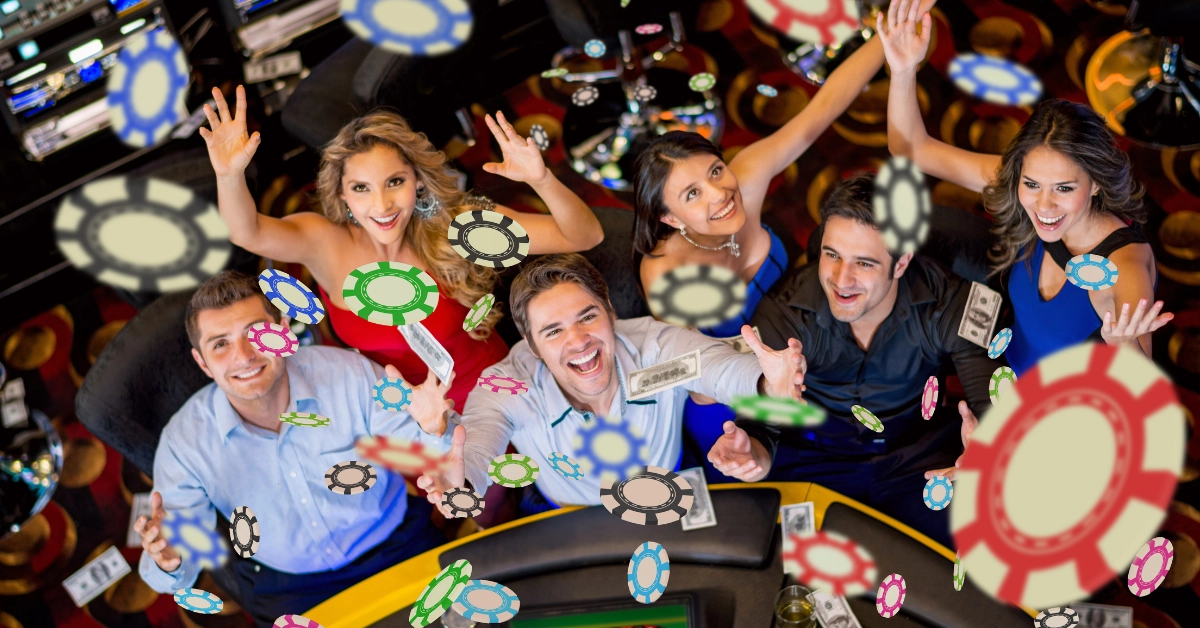
Casinos sure have a talent for making time disappear, like a magician pulling a rabbit out of a hat! You walk in, and the next thing you know, it’s five hours later, and you have no idea where the time went. Literally, hours have passed, and you don’t even realize it. Think it’s just because you’re having fun and focused on whatever game you’re playing? Maybe! But there’s more at play here than the cards in front of you—it’s all part of the casino’s plan.
From the second you enter, you are enveloped by an environment that is carefully crafted to keep you engaged. The sounds, the lights, and even the carpet design (yes, the rugs are in on it, too)—they are all there to influence how you feel and, ultimately, how long you stay. And while you might shrug it off as a coinky-dink, all of the little details have an influence on why it’s so easy to hang out for just a little bit longer…and spend more moolah.
Want to know why casino atmospheres are literally designed to keep you playing? We have all of the info—some harmless, and some of the more dastardly details about the how and why of it all!
The Psychology of Casino Design
Casinos are an entire world unto themselves. They are built and designed to make you feel excited be comfortable while you’re excited and plain unaware of how much time is wiling away. Every single thing is planned down to the last detail, with the end goal of keeping you inside and playing for longer than you meant to. The mixture of sounds, lights, and even smells in the air all work together for an environment that plays with your psychology in ways you are probably unaware of!
Behind all of these tactics is a principle that’s called operant conditioning—it’s a psychological concept that relies on rewards and reinforcements to influence behavior, and casinos are experts at using it. Slot machines, for example, use a reward system where wins come at unpredictable times. You don’t know when the next win will come, which keeps you on edge and excited. The “random rewards” build up a feeling of anticipation, so it can be hard to stop. Even if you’re losing, the occasional small win feels like a huge accomplishment, and that means you are going to keep engaging and be excited for the next round.
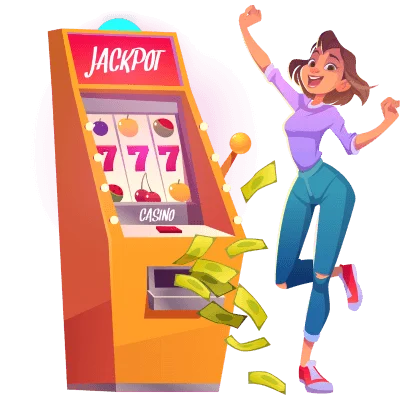
In addition to operant conditioning, the environment itself is tailored to keep players comfy and focused. The upbeat sounds of winning—bells, chimes, and coins falling—signal success and make you feel like the very next win could be yours. The constant whir of activity keeps you on your toes, but the lack of clocks or windows makes sure that time feels irrelevant. It’s not hard to totally lose track of how long you’ve been playing when there are no cues to remind you that the hours are just slipping away.
Another psychological trick is the idea of a “flow state,” which is where you become so absorbed in what you’re doing that everything else just fades into the background. Slot machines, with their repetitive motions and quick results, are really great at pulling players into this state. You’re continuously spinning, hoping for a big win, and before you know it, hours have passed. This hyper-focus makes it easier to continue playing, even when you had plans to stop long ago.
Casinos are also diabolical when it comes to playing on your senses! The bright colors and flashing lights make for an exciting atmosphere, and it just feels like something big is always about to happen. The scents that are used in the air, like lavender or citrus, are known to promote relaxation, so you’ll feel comfortable and relaxed while playing. All of these details work in harmony to create a space where you’re not just playing a game; you’re completely caught up in an experience that is difficult to walk away from.
Lighting and Sound Effects
Casinos are built to be sensory playgrounds—everything from the lighting to the sound effects is done with one goal in mind: for you to remain engaged and excited. Two of the biggest psychological tools they use are lighting and sound, which are strategically engineered for a welcoming atmosphere and to trigger emotional and neurological responses.
Bright, Inviting Lighting
Most casinos take advantage of soft, warm lighting to fashion a comfortable, inviting area. The idea here is to make players feel relaxed so that they’re more likely to stick around and keep betting. Soft lighting, especially in common areas like slot machine sections, helps generate a sense of intimacy and coziness. Instead of harsh, glaring lights, you get a warm glow that makes the area feel pretty homey and that fools your mind into thinking you’re in a place where you can relax and take your time.
On top of that, certain color schemes have the ability to trigger specific psychological responses. Studies have shown that red lighting can increase heart rate and arousal, which may push players into more high-stakes decisions, while blue lighting in lounges or rest areas gives off a sense of calm, which may give people a mental break or temporary respite—but it doesn’t encourage players to leave the premises. A balance between stimulation and relaxation is super important for casinos to sustain a prolonged and positive experience.
Music and Soundscapes
While the lighting produces a physical space that feels good to be in, sound is what keeps the vibe up. Casinos are filled with a constant stream of upbeat, rhythmic music. The tempo of the background music encourages faster decision-making and a heightened sense of urgency. Upbeat tracks with catchy hooks subconsciously energize players, helping them keep their focus and excitement level over extended periods of play. This is to keep the brain engaged, so you’re not just sitting at a machine—you’re part of a bigger, livelier affair.
Then there are the sound effects, which play a massive part in how players feel about their games. Slot machines, in particular, are designed with a literal symphony of chimes, dings, and jingles, with each sound being made to reinforce the excitement of the game. The sound of winning—coins clinking, celebratory beeps, and boops—makes you feel like you’ve hit the jackpot, even if you’re only winning a paltry amount. This triggers dopamine release in the brain, creating a sense of pleasure and reinforcing the behavior that led to that “win.” Even in near-miss scenarios, where the reels almost line up for a win, you still get the sounds that make players feel like they’re on the verge of success, which encourages them to keep going.
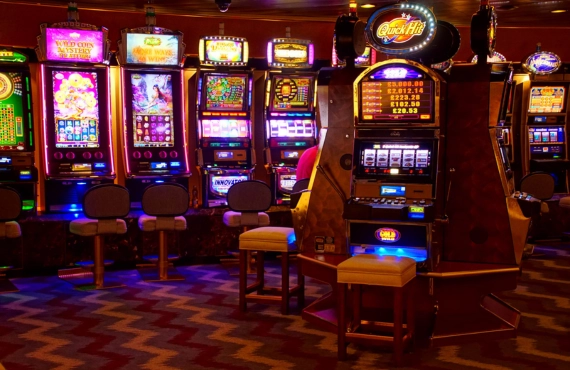
Interestingly, the winning sounds usually play even when the payout isn’t larger than the amount you’ve bet, a phenomenon that’s known as a “loss disguised as a win.” This slick use of sound reinforces the illusion of success, even when it’s a net loss, which keeps players at the machine longer.
The overall impact of lighting and sound in casinos can’t be overstated. As a duo, they fashion an environment that is alive and exciting, keeping players immersed in the experience, sometimes for hours on end. From the cozy lighting that helps you settle into the triumphant sounds of winning—even when you’re not winning big amounts of money—the design elements are about making the game feel like more than just a game. They tap into fundamental psychological triggers, making it hard to leave, even when logic says it’s time to go!
Layout and Design
Casinos aren’t just randomly designed buildings, no way. Every single inch of the floor is meticulously thought out in order to make dang sure you stay in the game longer than you originally planned to. From how you walk through the building to how easy it is to get more cash, it’s all part of the plan to keep you playing and, obviously, to keep you spending.
Maze-Like Layouts
How can finding your way around a casino feel so confusing? The disorientation is not a whoopsie or an accident–casinos are set up like mazes, with winding paths and lots of twists and turns. Instead of straight corridors that lead you directly to an exit, you’re guided through rows of slot machines, card tables, and other distractions.
The design isn’t solely about showing off what the casino has on offer—it’s meant to make sure you see as much as possible, giving you more chances to stop and play along the way.
On top of that, there are no windows or clocks to help you keep track of time. Casinos deliberately want you to lose all sense of time so that you stay in the game for longer. Whether it’s day or night, the lighting stays the same, and without any time cues, you won’t even notice how much time has gone by. The casino wants you to be immersed in the environment and in the games and not on when you should go home.
Strategic Placement of Games
As you stroll or wander through a casino, you’ll notice that some of the easiest-to-play games, like slot machines, are placed right smack in your path. Near entrances, along main walkways, and even near the bathrooms, the machines are there to grab your attention as you walk by. It makes it easy for you to stop, sit down, and give the game a go, even if you have no plans to play.
The machines are carefully positioned in high-traffic areas where you’re likely to walk past them a few times. And with their flashing lights and catchy sounds, they’re really hard to ignore. You might think, “I’ll just take a quick spin,” but that’s exactly what the casino wants. Once you start, you can get sucked in and keep playing.
ATMs Near Exits and Entrances
Now, let’s talk about ATMs. Casinos know that most people usually come with a set amount of cash they’re willing to spend. But once that money runs out, they don’t want you to leave, and that’s why ATMs are “conveniently” placed near exits or other high-traffic areas. As you’re about to head out, you’ll pass an ATM and think, “Maybe I’ll just get some more cash and play one more game.” It’s an easy but really effective way to nudge you to keep playing.
The setup makes it incredibly easy to access more cash without overthinking it. The ATM is right there, and you’re still in the zone from your previous games, so withdrawing more cash seems like a quick and perfectly logical decision! It’s all part of the casino’s game to keep you playing and spending for as long as they can.
A mix of sensory tricks and psychological tactics keeps the excitement up, and that makes it a no-brainer to stay for “just one more game.”
Casinos are designed to be a full sensory experience, and the layout is a huge part of that. By creating a disorienting, immersive environment where time feels irrelevant, and games are always within arm’s reach, they make it hard for you to leave. Everything from the maze-like paths to the placement of ATMs is there to keep you inside and playing for longer. It’s a smart, subtle approach that encourages impulse decisions and keeps you focused on the fun rather than the clock.
Free Drinks and Comforts
Casinos are experts at generating an environment where players feel comfortable, excited, and maybe a little bit uninhibited. And that’s where one of the powerful tools comes in—the free booze. Complimentary drinks and a luxurious atmosphere? Yes, please! But the free comforts aren’t just acts of generosity on a casino’s part; they’re a component of a bigger strategy to keep players occupied, chill, and spend more money.
Complimentary Drinks
Free alcohol in casinos is a well-known perk, but it’s got nothing to do with keeping you hydrated. Offering complimentary drinks, especially alcoholic ones, serves a much bigger purpose. Alcohol lowers inhibitions, making people more likely to take risks they wouldn’t usually take. After a couple of drinks, a player could feel braver and be willing to bet more or try their luck at a higher-stakes table. The sense of being “on a roll” can get amplified when you’ve been imbibing, and that’s just what the casino wants.
Anyone who drinks knows that alcohol doesn’t always equal the best decisions, so it can mess with a player’s ability to make clear, calculated decisions. A drink or two could make someone feel relaxed, but it also impairs their judgment, and that means more impulsive choices. Combine this with the already disorienting atmosphere—no clocks, no windows, flashing lights—and it’s obvious why free drinks are a strategic move. They will keep you in the game longer and increase the chances that you’ll keep betting even when you’re on a losing streak.

It’s not just the alcohol that matters, either. The basic act of offering a free drink makes people feel special, cared for, and pampered! The small gesture promotes a sense of reciprocity, where the player feels like they should stay longer or spend a little more to “pay back” the favor of a freebie. It’s a low-key psychological trick but one that works out well for the casino.
Luxurious Seating and Ambience
As the free drinks are flowing, casinos also make sure that the environment itself is really inviting. Walk into almost any casino, and you’ll notice the plush chairs, the soft carpets, and the warm lighting. Everything about it is meant to make you feel comfortable and relaxed so you’ll stay.
The seating, in particular, is a big part of this strategy. Casino chairs are built to be ergonomic and cushioned, making sure you stay as comfy as possible while you play. These aren’t the stiff, wooden seats you’ll find at a local watering hole; they’re the kind of chairs you’d sink into at a luxury hotel. If you’re sitting at a slot machine or table, chances are you’re in a chair that was built to make you feel relaxed but still alert—just snug enough to forget how long you’ve been sitting there.
In addition to seating, the general ambiance has its part to play as well–casinos are designed to be visually appealing and inviting. The décor usually has rich, warm colors like golds, reds, and deep purples, which mimic a sense of luxury and comfort. Soft lighting further improves this cozy atmosphere, making the space feel intimate and personal. This environment helps players relax and makes them feel like they’re in an exclusive, high-end setting where it’s okay to let loose and spend a little extra.
The idea behind all of these comforts is to create an atmosphere that encourages players to stay as long as possible. If you feel at home, with a free drink in hand and a comfortable seat beneath you, it’s much harder to think about leaving. Instead, you’re more likely to continue playing, which is exactly what the casino is hoping for.
By plying you with free drinks and crafting a luxurious atmosphere, casinos make sure their players are both physically comfortable and mentally primed to take more risks. It’s a sly combination of hospitality and psychological warfare that keeps players in their seats and betting for longer than they thought they would.
Rewards and Loyalty Programs
Casinos get people to play in ways that feel rewarding, even if the rewards are rarely as big as you’d like! The use of small, regular wins keeps you interested, and they sweeten the pot with loyalty programs that make you feel like you’re part of something important, like a VIP. It’s this kind of combo that works on both your emotions and your habits, and it subtly encourages you to hang around and play for longer than you originally thought you would.
Small Wins That Keep You Going
The sorcery of small wins is that they make it seem as if you’re making progress, even when you aren’t walking away with any kind of big payout. Slot machines are so good at this—they’re designed to give you that little boost every now and then, and it’s just enough to make you think you’re getting somewhere. You could win back a portion of what you’ve spent or enough to cover your last bet. It’s definitely not enough to make you rich, but it’s enough to keep you going. The idea is to create a sense of momentum, where it feels like a big win is coming up.
This plays into a psychological effect known as “variable reinforcement.” The randomness of when these small payouts happen keeps you invested because you never know when the next one is coming. It taps into the same reason why people get hooked on social media notifications or why they keep scrolling for the next interesting post. It’s that hope of getting something exciting on the next spin or hand that keeps you locked into the game.
And these wins don’t just come from slot machines—table games like blackjack and roulette work in similar ways. A couple of good hands or spins might make you think you’re on a lucky streak, even if you’ve lost more than you’ve won. It’s all part of the experience that casinos engineer to keep you coming back for one more round.
VIP Programs and Loyalty Schemes
The excitement of winning—even in small doses—is more than enough to keep people engaged in the short term, but casinos also depend on loyalty programs to build long-term relationships with their regulars. The programs are designed to reward players for sticking around and playing consistently. Every time you place a bet, you’re earning points that you can redeem for rewards like free meals, discounted rooms, or even cash back. As you continue to play, you accumulate more points, which can unlock even better rewards. The higher you climb in the loyalty tiers, the more exclusive the perks become.
VIP programs take these rewards to a whole ‘nother level for serious players. Once you’ve reached a certain threshold, casinos start treating you like royalty. You might get a personal account manager who handles your every request, or you could be invited to exclusive events, tournaments, or even luxury vacations. These programs are designed to make you feel like you’re part of an elite group, offering perks that you wouldn’t find in any regular loyalty scheme.

What’s so smart about these programs is that they create a sense of belonging. Once you’ve started earning points or achieving VIP status, it becomes harder to walk away. You’ve already invested time (and money) into building up your status, and leaving for another casino means starting over from scratch. And this sense of loyalty is just what casinos are banking on—they’re rewarding you for your continued play, but at the same time, they’re making it harder for you to leave and go somewhere else.
The combo of small wins and loyalty rewards makes for a powerful strategy. Whether you’re racking up points or hitting little wins, you feel like you’re always getting something back, which keeps you engaged. By the time you realize how long you’ve been playing or how much you’ve spent, it’s usually too late to walk away.
Lack of Time Awareness
Casinos use sneaky tricks so that players will completely lose track of time, and two of the main elements in this strategy are the absence of clocks or windows—and that they’re open 24-hour hours. All of these factors work together to blur any sense of how long a player has been inside; it’s an environment that pulls people into long, uninterrupted gambling sessions.
No Clocks or Windows
One of the most noticeable aspects of any casino is the lack of clocks or windows. This is done on purpose, making it easy for players to lose their natural sense of time. Without sunlight or clocks, there are zero visual cues to indicate how long you’ve been playing. Time tends to slip away when there are no outside markers, so you’re aware of its passage.
The lighting and sounds inside the casino are always set to feel the same, whether it’s day or night. The absence of windows keeps players inside a bubble where the world outside might as well not exist. By removing these external markers, players stay fully immersed in the casino’s environment, where the only focus is on the next game or the next spin.
24/7 Operating Hours
Another main factor in making time feel irrelevant inside a casino is the fact that they never close. Like, NEVER. Unlike most businesses that shutter at a certain hour, casinos are open around the clock, so it’s super easy for people to stay longer than they expected to. With no closing time to remind you that it’s getting late, players just keep going, as there’s no external reason to hit the road.
Whether it’s 11 a.m. or 4 a.m., the games are always running, and the atmosphere is the same. The continuity removes any natural signal that it might be time to call it a night (or day), and players are drawn into longer sessions simply because the casino never stops.
The Role of Aromas
The use of scent in casinos isn’t just to make it smell nice, although that’s a bonus! No one wants to hang out in a stinky joint. Scent marketing is a tool that’s crafted to influence player behavior so that the environment is more pleasant, which, in turn, you guessed it, can mean longer stays and higher spending. It taps into our sense of smell, which is directly linked to the brain’s limbic system, the part responsible for emotions and memories. The nose knows, and it’s a powerful way to improve a player’s experience.
Scent Marketing
Casinos will pump specific fragrances into the air to create a more welcoming and enjoyable atmosphere. As we said above, this tactic isn’t just to make the casino smell good; it’s designed to evoke emotions and memories that keep players feeling comfortable and at ease.
A study conducted by Dr. Alan Hirsch found that in scented areas of a casino, players spent 45% more time at slot machines compared to the unscented areas.
In addition to increasing time spent on the floor, scent marketing can also add to creating a unique brand identity for casinos. Some big establishments, like the Wynn Las Vegas, have their own signature scents, which are a blend of floral and citrus notes to craft an upscale and luxurious feel. The branding through scent helps in creating a lasting memory for visitors, which increases the chances of them coming back.
Boosting Player Comfort and Spending
Different scents are known to trigger various emotional responses, and casinos carefully choose fragrances that improve player comfort. Lavender is known for its relaxing properties, and citrus scents are said to energize and invigorate. Both types of fragrances can positively affect the player’s mood, making the place feel more enjoyable and increasing the likelihood that they’ll keep on playing. Studies show that the introduction of certain aromas can increase spending by nearly 45% in scented areas compared to unscented zones!
By pumping pleasant-smelling fragrances into the air and tailoring those scents to trigger emotional responses, casinos create environments that are both relaxing and stimulating. Whether it’s with energizing citrus or calming floral scents, this approach helps to level up the whole experience, and players feel more relaxed and comfortable while they play—without them realizing just how much influence the aroma has.
Famous Casino Designs
Some of the most famous casinos in Las Vegas have carefully designed their spaces to keep guests entertained, comfortable, and constantly exploring. These designs go past gaming, manufacturing entire environments that bring people in for way more than just a few rounds at the table. We want to explore the distinct features of three of the most famous casino designs: The Bellagio, Caesars Palace, and the MGM Grand.
The Bellagio, Las Vegas
The Bellagio is known for its calm elegance and sophisticated charm. From the second you set eyes on the famous fountain show outside, which plays to music and lights, you get a sense that this is a place that is meant to soothe and impress. The design is inspired by Italy’s Lake Como, with marble floors, grand chandeliers, and lush Mediterranean gardens throughout the entire property. The Bellagio wants you to feel like you’re in a serene European retreat, which is far removed from the commotion of the Las Vegas Strip.
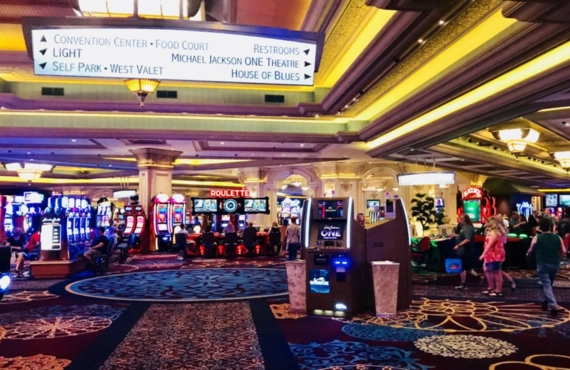
The interior design of the Bellagio continues on its theme of elegance. There’s a curated art gallery, fancy restaurants, and upscale shopping, all of which add to the feeling that this is a place for relaxation as much as it is for excitement. The whole environment is luxurious but not overwhelming, so it’s a more peaceful alternative to some of the other casinos on the Strip.
Caesars Palace
Caesars Palace goes in a completely different direction—one that’s more about scale and spectacle. When you walk through its massive doors, you’re surrounded by towering columns, Roman statues, and dramatic fountains. The entire casino is designed to feel larger than life, and that’s exactly the point. Everything, from the décor to the layout, is meant to impress.
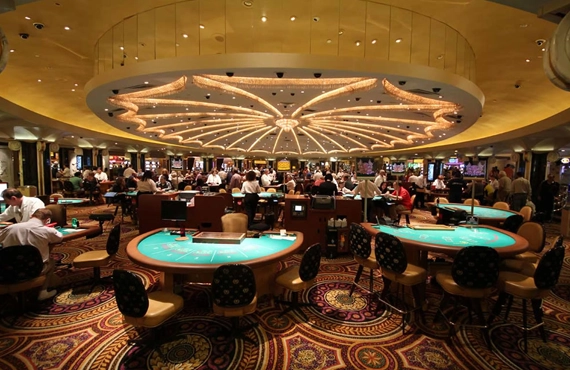
Caesars doesn’t just rely on its grand architecture to keep visitors intrigued—it’s also a feast for the senses, with flashy lights, loud music, and non-stop activity. The energy is palpable, and the layout makes sure that there’s something visually striking wherever you look. The busy, lively atmosphere is meant to entertain, whether you’re gambling, shopping, or just taking in the excitement around you.
MGM Grand
The MGM Grand takes a slightly more modern approach, and it uses technology and innovation to keep guests interested. It’s one of the biggest hotels in Las Vegas, and everything about it feels big. From the sprawling casino floor to the various entertainment venues, there’s a sensation of constant motion. The design uses bright, bold colors, interactive digital displays, and high-tech gaming areas to keep the energy going and the visitors moving.
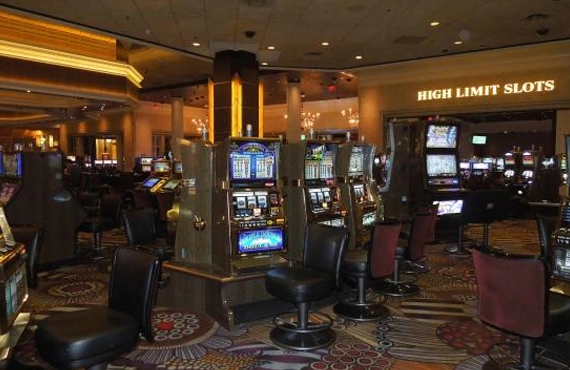
One of the absolute best features of the MGM Grand is how it uses its layout to guide people through different areas seamlessly–whether you’re there for the casino, a show, or one of the many restaurants, the design means that you’re never far from the action. The layout draws people from one part of the casino to the next, ensuring that there’s always something new to discover. The atmosphere is lively and modern, with a focus on fashioning an immersive experience that is exciting and high-energy.
Each of these casinos has its own way of drawing visitors in. The Bellagio is luxurious and calm, Caesars Palace dazzles with grandeur and spectacle, and the MGM Grand is modern and tech-forward. If you’re looking for relaxation, excitement, or innovation, these iconic spots have it all!
The Ethical Debate
Casinos are built around the idea of entertainment, but there’s always been a conversation about where the line is drawn between fun and manipulation. Yes, people go to casinos for entertainment, excitement, and sometimes even to relax, but the way casinos are structured can push some to spend more time and money than they intended to. This brings us to our ethical question: is the design and operation of casinos manipulative, or is it merely smart business? And what are casinos doing, if anything, to help players gamble responsibly?
A casino feels like an entirely different world—one with lights, sounds, and a sense of anticipation. But casinos intentionally remove clocks and windows, use dim, inviting lighting, and play upbeat music to mess with the passing of time and encourage people to stay longer. Players can spend hours at a machine or table without knowing how much time has gone by.
The question that always comes up is whether this kind of environment is manipulative. Critics argue that these types of techniques prey on human psychology, especially when it comes to risk-taking behavior. As an example, slot machines are programmed to give players small wins that are just enough to create the illusion of being close to hitting a jackpot. These wins trigger dopamine in the brain, making the player feel good even if they’re losing money in the long run. The lighting, sounds of winning, and constant activity are all built to keep players in a heightened state of excitement.
Some people argue that these tactics cross the line into manipulation, as they build an environment that encourages risk-taking behavior and exploits the brain’s natural response to rewards and anticipation. People are way more likely to make impulsive decisions and spend more money than they planned, and casinos know this. And complimentary alcohol makes a difference, as it lowers inhibitions and makes players feel more confident than they should in terms of taking bigger gambles.
Then there are those who truly believe that casinos are just providing entertainment and it’s up to individuals to set their own limits. From this perspective, as long as the games are fair and transparent, casinos are just one more form of leisure and not so different from a theme park or a concert. They’re providing a service, and players are responsible for managing their own spending and playtime.
Casinos have been increasingly aware of the ethical concerns surrounding gambling, and most have made efforts to address problem gambling. One of the ways they do this is by incorporating tools that help players keep track of their time and spending. These tools range from reminders that let people know how long they’ve been playing to options that allow players to set deposit and betting limits before they start gambling.
All reputable casinos, both physical and online, now have self-exclusion programs, where players can voluntarily ban themselves from the casino if they feel like their gambling habits are becoming problematic or out of control. Once a player signs up, the casino is legally required to refuse entry or deny access to gaming services. Some casinos have begun using artificial intelligence (AI) to track patterns of play and identify people who could be in danger of developing a gambling problem. In these cases, staff will reach out to the player or limit their ability to bet large sums of money.
Some casinos are also funding research and education aimed at tackling problem gambling. Take MGM Resorts—it has contributed to programs that are designed to educate young people about gambling risks and provides resources for people who may be struggling with addiction. By investing in these initiatives, they are trying to balance their business interests with a genuine concern for their customers’ well-being.
At the center of the debate is a fine line between entertainment and exploitation. On one side, there’s the argument that people should be free to enjoy themselves at a casino, and any attempts to regulate the experience would be overstepping. On the other side, critics argue that casinos, with all their sensory tricks and psychological tactics, are setting people up to fail. The bright lights, lack of time cues, and rewards are designed to keep you spending.
In the middle of this debate are the casinos themselves, many of which are trying to maintain their role as entertainment providers while also addressing the social issues connected to problem gambling. It’s not only about complying with regulations—it’s about whether casinos can balance making money with keeping their customers safe.
The question of whether or not casinos are manipulating their patrons or just giving them a chance to have a fun time depends on who you ask. The way these places operate obviously influences behavior, but it’s also clear that some people can go to a casino without being in danger of developing any risky habits. At the same time, for those who are vulnerable to gambling problems, the immersive, exciting nature of casinos can result in negative consequences—sometimes life-changing ones. This is why responsible gambling initiatives, which are implemented to mitigate some of the dangers, are becoming such a big part of the industry’s conversation.
Conclusion: Are You Playing or Getting Played?
Look, we most likely didn’t tell you anything you didn’t already know or shock you about how casinos operate. The whole “no clocks or windows” isn’t exactly a secret, but that doesn’t mean it’s not a manipulation tactic. Along with the lights, smells, and free drinks, you can get carried away without knowing what is carrying you off with the casino fairies. So keep your wits about you—the casino is not going to help you out there!
- It’s WHAT Time?: No clocks or windows make it almost impossible to tell how long you’ve been playing, and you don’t even realize it.
- Lights and Sounds: Flashing lights and happy noises trigger excitement and keep the energy way up so that the whole space feels alive.
- Scented Air: Subtle fragrances make the environment more welcoming, which makes you more likely to feel comfortable and stick around longer.
- Game Placement and Layout: Casinos are laid out like mazes, so even if you are heading somewhere specific, you end up passing more games and are tempted to play.
- Small Wins and Rewards: Regular little payouts and loyalty programs make players feel like they’re progressing, even if a big win is elusive.
- Comforts & Free Booze: Free alcohol and comfy seating make it easier to stay, loosens up decision-making and encourages people to play longer.
Final Thoughts
Casinos use super slick techniques to keep you in a state of “What time is it?” and even though it’s great for business, you have to know how it influences your gambling behavior! They’ve got the “pull you in and keep you there,” down to a science, but being aware of how they employ these tactics on you will help you play responsibly. So soak up the atmosphere, but set your own limits to make sure you’re always in control. And wear a watch!

Alyssa contributes sportsbook/online casino reviews, but she also stays on top of any industry news, precisely that of the sports betting market. She’s been an avid sports bettor for many years and has experienced success in growing her bankroll by striking when the iron was hot. In particular, she loves betting on football and basketball at the professional and college levels.








